|
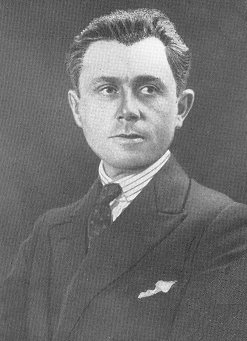
Louis Hervé
Coatalen. |
1909 was a landmark year for
the company because they appointed Louis Hervé
Coatalen as chief engineer, and thanks to him
Sunbeam would go from strength to strength. He was a
greatly experienced French-trained engineer who was
born at Concarneau, Department Finisterre, in 1880.
He trained as an engineer at the “Gadzarts”; the
Ecole des Arts et Metiers, on a three year, seven
days a week course. He only had two week’s holiday
each year and during that time he still had plenty
of preparation work to do. The course gave him an
excellent grounding in engineering theory and
mathematics and practical experience would soon
follow.
After completing the course he
worked in the drawing offices of Panhard, Clement,
and De Dion-Bouton, which gave him invaluable
experience in automobile design, engineering and
building, with three of the leading French motorcar
manufacturers. |
| In 1901 he came to Coventry after
obtaining a post with the Humber Car Company and designed the 10/12hp. Coventry
Humber car, which sold in large numbers and secured the future of the company.
He married Annie Davies in 1902 and they were divorced four years later. He soon
joined Mr. Hillman and they formed the Hillman-Coatalen
Motor Car Company in 1906. The company produced the
Hillman-Coatalen car, which so impressed Thomas Cureton that he offered Coatalen
the job of Chief Engineer at Sunbeam. In February 1909 Coatalen
sold his shares back to Hillman and moved to Wolverhampton.
Although destined for greater things, it seems that
Sunbeam got off to a rather slow start. The cutting
below, dated 2nd December, 1909 is from The
Wolverhampton Journal: |
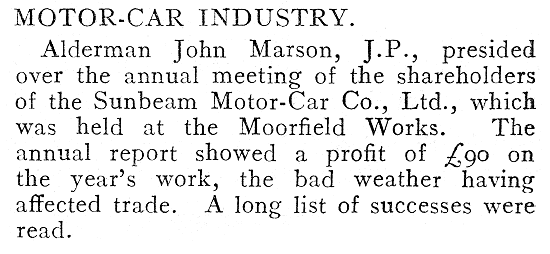
| Until now Sunbeam had brought-in many of
their parts, but under Coatalen most were now made in-house. His first car, the
14/20hp. was a modified Shaw design using a 3.4litre, 4 cylinder engine. Nearly
200 were built. Coatalen greatly enjoyed motor racing and competed in the sport
himself. He decided to raise Sunbeam's profile by involving the company in motor
racing and set up a competition department. His slogan was 'Racing improves the
breed'. Sunbeam had numerous racing successes which resulted in many
improvements being made to their designs. He entered a 14/20hp. car in the RAC
“Ten Pound Note” Trial which consisted of a 100 mile road section followed by a
race on the Brooklands track. The trial was a great success for Coatalen as he
achieved a fuel consumption of 21.3m.p.g on the road section, an excellent
performance at the time, and an average speed of 56.65m.p.h. at Brooklands. He
was so thrilled with the race at Brooklands that he decided to build a
streamlined racing car for competition work and publicity. Such a car could well
capture the public’s imagination and promote the Sunbeam name. The new car,
called “Nautilus”, appeared at Brooklands in March 1910. |

Louis Hervé
Coatalen. |
| It had a cigar-shaped
streamlined body built from wooden slats mounted on
hoops. The nose and tail consisted of polished brass
cones. The 4.2 litre, 4
cylinder engine had 16 overhead valves, operated by
push-rods and rockers, from two camshafts, one on
either side of the crank case.
|
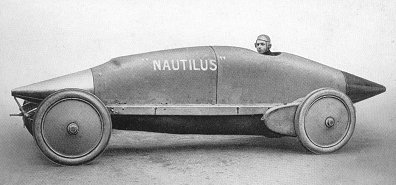
Louis Coatalen and the
"Nautilus". |
| Unfortunately the car
suffered from overheating problems, because the
radiator in the water-cooled engine was fed with air
from a small hole in the nose, which proved to be
insufficient. In practice the rear half of the body
was removed when racing, to try and overcome the
problem. Unfortunately this didn’t work and even
after several modifications the car was still
unreliable. Undaunted however, Coatalen was learning
from his mistakes and much improved designs would
soon follow. |
|

A 12/16hp. 2-seater car. |
His next car, the 12/16hp.
was well received by press and public alike.
Coatalen had a great dislike of chain drives and so
this car became the first Sunbeam to have a shaft
drive. The first 12/16 appeared in 1910 and many
improvements were made during its four-year
production life. The 2.4litre, 4 cylinder engine,
initially consisted of cylinders that were cast in
two blocks of two. |
|
By 1911 Louis had married for a
second time. His new wife was Olive Bath, daughter
of Sunbeam director, James Henry Bath. They lived at
Waverley House in Goldthorn Road, Wolverhampton,
next to the Royal Orphanage, which later became the
Royal School.
From 1912
onwards a monobloc engine replaced the earlier
design, and the petrol tank, originally mounted
below the front seats, was now mounted between the
rear springs. The car has a cone leather clutch, a
4speed and reverse gear box, and a drive shaft onto
the live rear axle. In 1914 a generator and electric
lights were added. The car was economically priced
for a Sunbeam and available in several versions: a
5-seater Tourer - £360 to £396, a Landaulette - £500
to £550, and a running chassis - £330 to £350. Just
under 5,000 were built and from 1913 onwards,
sporting models would also be produced. Due to the
car's success, immediate expansion was required at
Moorfield Works, and so in 1910 more buildings were
added. |
|
The other new 1910 models were the
16/20hp. and the 25/30hp. The 16/20 featured a 3.8litre, 4 cylinder engine and
is otherwise very similar to the 12/16. The car remained in production until
1914 and just under 1,000 were built. The following versions were available:
5-seater Tourer - £475 to £540,
Landaulette - £615 to £640, Running chassis - £445 to £475.
|
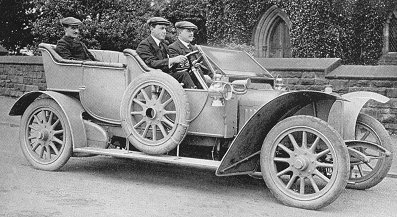
A chain drive 16/20hp. car
with Coatalen at the wheel. Only three were built
with chain drive, the others had a live axle. |
|
The 25/30 was similar to the 16/20 and
initially came with a 4.67litre, 4 cylinder engine. From 1912 until production
ended in 1914, a 6.1litre, 6 cylinder engine was fitted. Just under 500 were
made and the following versions were available:
5 seater Tourer - £550 to £635,
Landaulette - £690 to £760, Running chassis - £520 to £600.
The 18/22hp. model appeared in 1911, but
less than 60 were made. It had a 6 cylinder, 3,619c.c. engine and as usual was
available in the following versions:
5 seater Tourer - £525, Landaulette - £665, Running chassis -
£495.
|
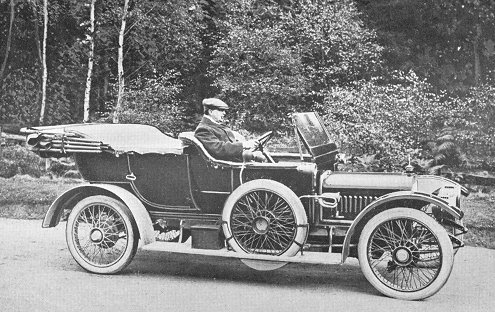
Thomas Cureton driving a 16/20hp.
|
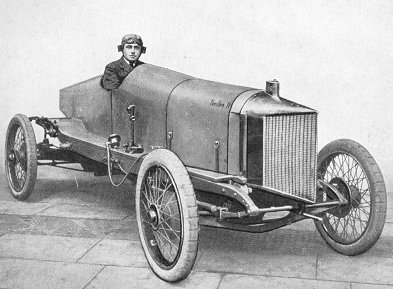
Coatalen and
“Toodles II”. |
Undaunted by the unsuccessful
“Nautilus”, Coatalen designed a successful
replacement called “Toodles II”, after his pet name
for Olive, his wife.
The car featured a new
3.2litre, 4 cylinder engine that had a chain-driven
overhead camshaft and developed 63b.hp. at
2,600r.p.m.
The car, driven by Coatalen
himself, won 22 prizes during the 1911 season and
bought much welcomed publicity for both himself and
Sunbeam.
|
| The car first appeared during
the Easter event at Brooklands and achieved 83m.p.h.
when it beat C.A. Bird’s 60hp. Napier in a match
race between the two cars. The following day, also
at Brooklands, Coatalen set a new 16hp. record of
86m.p.h. in the Flying Half Mile. Later in the
season, again at Brooklands he set a new long record
for 10 laps at an average speed of 79.29m.p.h.
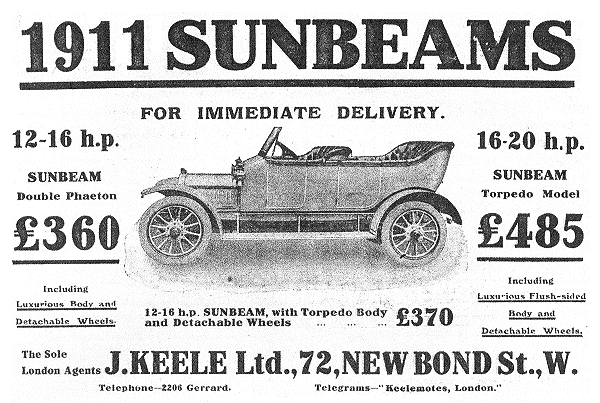
An advert from 1911.
After these wonderful
achievements both Coatalen and Sunbeam were becoming
well known in the British racing world. In the same
year the company first competed in European road
racing by entering a car in the Coupe de L’Auto at
Boulogne on 25th June. The car, driven by
T. H. Richards was basically a standard 12/16.
Unfortunately the car was forced to retire whilst in
7th place, due to a broken steering connection after
a bump with the kerb. Sunbeam however would go on to
greater things and much effort was made for the
following year.
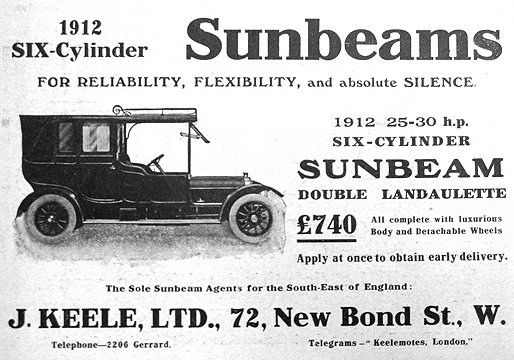
An advert from 1912.
In January 1912 Coatalen was
appointed to a seat on the Board of Directors, in
recognition of his valuable work at Sunbeam.
The company engaged some of
the best continental drivers including Dario Resta,
Emile Medinger, and Victor Rigal. Four 12/16s were
entered in the Coupe de L’Auto, held over a 47 mile
circuit at Dieppe. The cars were basically standard
machines with small modifications to the engine and
special tuning. Only cars of up to 3litres could
enter the race, which was run at the same time and
on the same course as the French Grand Prix, in
which there were no restrictions on size. |
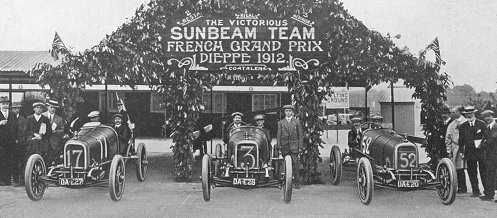
The 1912 team. Left car: Dario Resta and Tommy
Harrison, middle car: Victor Rigal and Jean
Chassagne, right car: Emile Medinger and Isaac
Strothers. |
| The Sunbeams performed
extremely well with Rigal finishing in first place,
Resta second, and Medinger third. Due to their
astonishing speed they were also placed in third,
fourth, and fifth places in the Grand Prix itself,
beating many, much more powerful machines.
|
| Rigal averaged 65.35m.p.h.
over the 956 miles, only 3m.p.h. less than Boillot
in his 7.6litre Peugeot.
Coatalen and the team; Dario
Resta, Emile Medinger, Victor Rigal, Georges
Caillois and their mechanics were invited to a
celebration banquet by the RAC committee on 11th
July. |
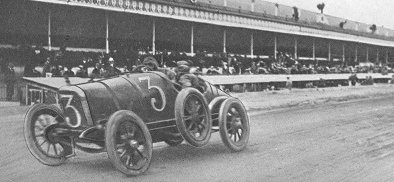
Victor Rigal during the race. |
|
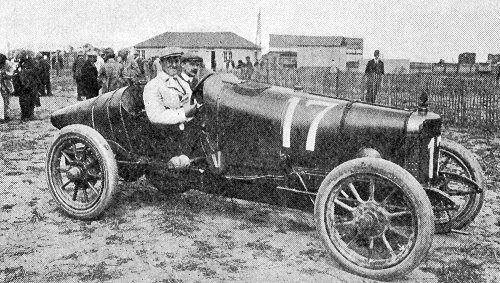
Dario Resta and Tommy
Harrison. |
|
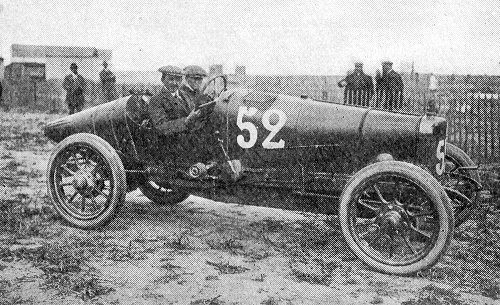
Emile Medinger and Isaac Strothers. |
|
During the proceedings Louis Coatalen
was presented with a beautiful silver cup to commemorate the victory, gold
medals were presented to the three winning drivers, and bronze medals to the
mechanics.
To
celebrate and capitalise on their success in
1912, Sunbeam produced what was possibly the
world’s first sports car, the Coupe de L’Auto
Replica. The cars were produced in 1913 and 1914
and were available as a 2 seater from £425, or a
4 seater from £440.
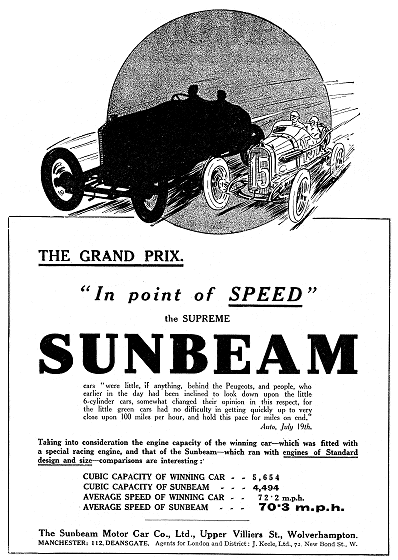
An advert from 1913.
Coatalen
decided to take part himself in the 1913 French
Grand Prix at Amiens, clearly spurred on by the
victory in 1912. Four special cars were built
for the race, each powered by a 4.5litre, 6
cylinder engine. Jean Chassagne, driving one of
the Sunbeams finished in 3rd
place at an average speed of 70.3m.p.h. over the
579 miles. Later that year, one of the cars,
fitted with a single seater body, broke many
existing records during a meeting at Brooklands.
The car, driven by Jean Chassagne, Dario Resta,
and Kenelm Lee Guinness ran for 12 hours during
which it succeeded in breaking all of the
world’s records from 2 to 12 hours and from 200
to 1,000 miles. The average speed over the 1,000
miles was 90m.p.h. and for the 2 hours, the car
averaged 97.5m.p.h. A great success indeed.
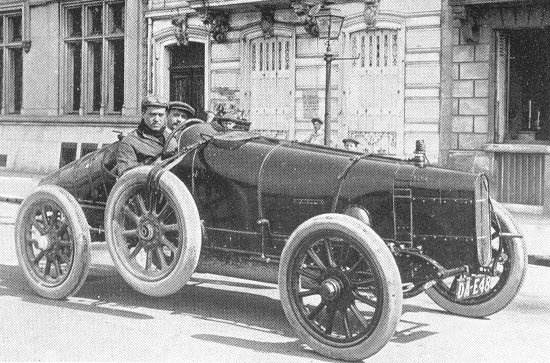
One of the 1913 French Grand Prix cars.
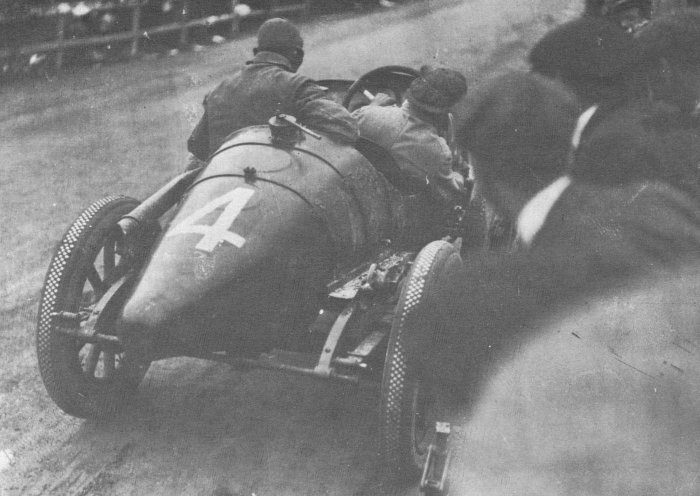
Jean Chassagne leaving the pits.
In 1913, the Coupe de L’Auto was held as
a separate event and Sunbeam set out to defend their previous victory with three
similar cars to the ones used in 1912. They were driven by Jean Chassagne, Dario
Resta, and Kenelm Lee Guinness, on a more difficult course near Boulogne.
Unfortunately the team didn’t manage their previous year’s sweeping success.
Both Chassagne and Resta were forced to retire with broken rear axles, but
luckily Guinness, the only team member to finish the race, saved the day by
coming in 3rd, nine minutes behind the winner at an average speed of
61.45m.p.h.
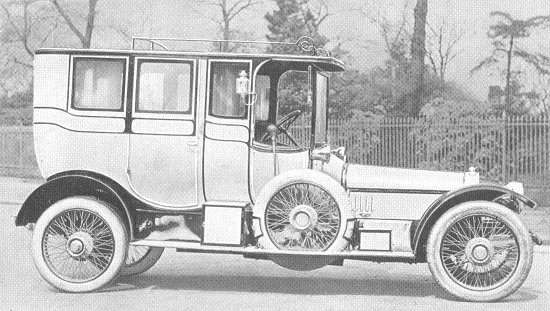
A 1913 Sunbeam with special coach work.
By this time Sunbeam were
already producing aircraft engines and had a
‘Crusader’ 6litre, 150hp. ‘V8’ engine flying in
a Henry Farman biplane. Coatalen had one of
these fitted into a 24hp. chassis and tried it
out with some success at Shelsley Walsh in June,
1913. By August, a new racing car called
‘Toodles V’, the fifth of its line, and the
first racing car to be powered by an aero
engine, was ready for action. It consisted of a
‘V12’ airship engine fitted into a 25/30hp.
chassis. The car achieved some success in 1913
and 1914 and would go on to be raced in America
during the First World War, when racing was
banned in Europe.
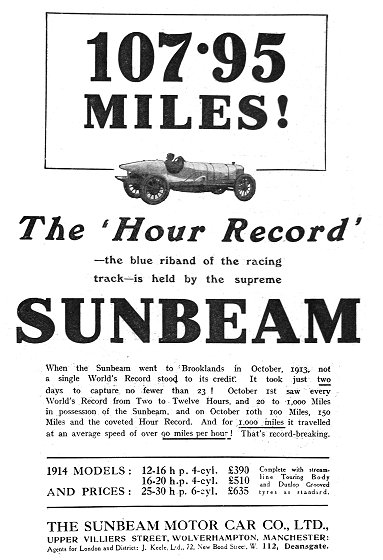
An advert from February 1914.
In 1914 the RAC decided to
revive the Isle of Man Tourist Trophy as an
event for cars, and Coatalen rose to the
occasion by designing a new car, powered by a
3.3litre, 4 cylinder, 16 valve engine, which
wasn't quite as it seemed.
The first and second places in the 1913 Coupe de L’Auto
had been taken by Peugeot. Their cars, designed by Ernest Henry, were far
more powerful than the Sunbeams, and Coatalen realised that his existing cars
stood no chance against Peugeot's more powerful twin
overhead camshaft engines. He decided to get his hands on a 1913, 3-litre Coupe
de L'Auto Peugeot, examine it in detail, and design a new car based upon it. It
has been suggested that he purchased one of the cars and brought it to
Wolverhampton with this in mind, but it seems that the real story is a little
more dramatic. His good friend, and Sunbeam racing car driver, Dario Resta,
had been given the job of driving the 1913 Coupe de L'Auto
winning car to all of Peugeot's French agents as part of a publicity exercise. Coatalen arranged for Jean Chassagne to collect the car, and drive it to
Waverley House, Goldthorn Road, Wolverhampton, where Louis and Olive Coatalen lived. Once there, the
car was closely examined, and stripped down. Detailed drawings were made of all
the parts by two of Sunbeam's draughtsmen, Hugh Rose and Ted Hatlands.
When the car was re-assembled, it was driven to Moorfield
Works so that the engine could be bench tested, before returning it to France.
The whole operation was carried out in great secrecy, so that Sunbeam could
claim full responsibility for the design of the 1914 car. The T.T. Sunbeam had
an identical engine with an enlarged bore and stroke, and was capable of
producing 100 bhp.
3 Sunbeam cars
were entered for the 600 mile race that was to
be run over two days, with 8 laps, each of 37.5
miles being completed on each day. |
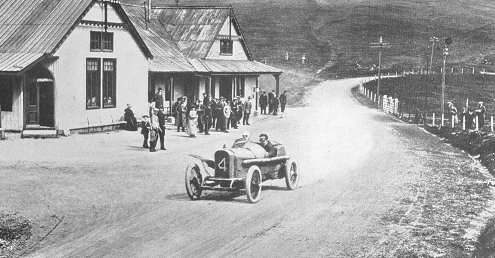
Kenelm Lee Guinness in
action during the 1914 Isle of Man T.T.
|
The race took place on the 10th and 11th of June.
The Sunbeam drivers were Dario Resta, Kenelm Lee
Guinness and his elder brother Algernon. Unfortunately Resta had to retire
during the first day due to a broken big end nut, but on the second day K.L.G.
and Algernon were in first and second places respectively. All continued to go
well until Algernon started to have problems with the lubrication of a universal
joint. Unfortunately the joint seized and he had to retire. Kenelm however, went
on to finish the race in first place, at an average speed of 56.44m.p.h. For his
achievement he was awarded the Henry Edmunds Trophy.
In 1914 Thomas Cureton retired from the
position of Managing Director and was replaced by William Markley Iliff and Louis Coatalen,
who were appointed as Joint Managing Directors.

The original founders, and the company directors in 1919.
Even after the outbreak of war, when
Sunbeam were involved in war work, several cars were produced. The 16hp.
appeared in 1915 and continued in production into 1916. The car, a development
of the 12/16hp. model, was powered by a 3litre, 4 cylinder engine and looked
quite modern with its upright radiator. The following versions were available:
Running chassis - £350, 5-seater Tourer
- £440, 2-seater - £417.10s., Coupe - £525, Sporting Model - £470.

A Sunbeam 16hp. tourer.
Just over 1,600 were made. A larger
version, the 20hp. was also produced and just over 100 were built. During 1915
and 1916 a 30hp. model was also produced, featuring a 6.1litre, 6 cylinder
engine, but only 15 were built. The cars could also be supplied with a Sunbeam
Air Compressor Self-Starter, for an extra £40.
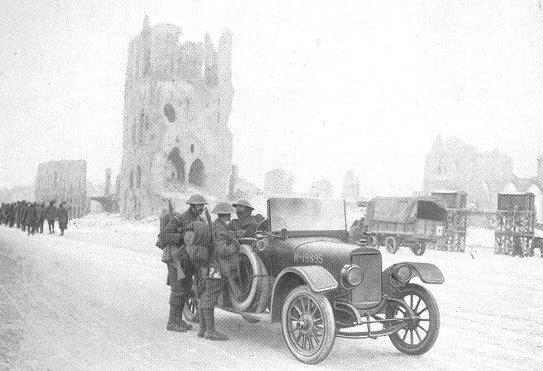
A 16-20hp. Sunbeam staff car.

A 16-20hp. Sunbeam
ambulance
In 1916, the Coatalens moved to Bromley House, Penn Road,
Penn, where they lived until 1919. The house was sold at auction on 18th March,
1919.
At this point car production ended at
Wolverhampton for several years because the Ministry of Munitions ordered the
company to concentrate solely on war work involving aircraft and aircraft
engines. There was still a demand for the 16hp. Sunbeam car for such use
as staff cars and ambulances and so a licence was given to Rover to produce
them. The Rover versions carried the Rover name and it has been suggested that
the crafty Coatalen tinkered a little with drawings before they were passed on
to Rover because the Rover versions were not as powerful as the Wolverhampton
built equivalents.
The demand for the company’s aircraft
and aero engines was so great during the war, that Moorfield works had to be
vastly expanded to cover several acres.
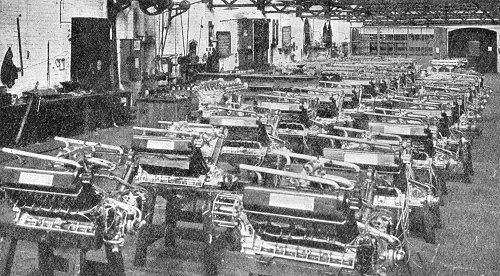
Aero engine production at the works.
|
 |
|
 |
|
 |
Return to
the
Sunbeam Motor
Car Co. Ltd. |
|
Return to
the beginning
|
|
Proceed to
After The War
|
|